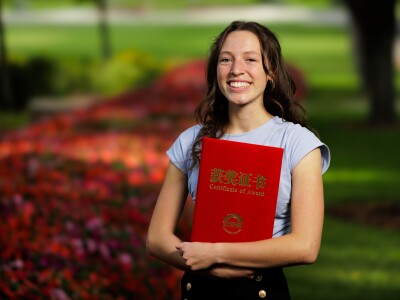BYU research advances a technology to monitor nuclear production
For most people, infrared technology calls to mind soldiers with night-vision goggles or energy audits that identify where heat escapes from homes during the winter season.
But for two Brigham Young University professors, infrared holds the potential to spot from afar whether a site is being used to make nuclear weapons.
Statistics professor Candace Berrett developed a model that precisely characterizes the material in each pixel of an image taken from a long-wave infrared camera. The U.S. National Nuclear Security Administration funded the project through a grant awarded to BYU engineering professor Gustavious Williams.
The government’s long-term goal for infrared technology is to remotely detect the exact materials, chemicals and gases coming and going from factories or other sites suspected of illegal nuclear production. Berrett and Williams tested their new method of analyzing infrared images with more basic materials using data taken by Lawrence Livermore National Laboratory. The results appear in a report published by the journal Technometrics.
Infrared cameras capture wavelengths of light that are not visible to the human eye. Hyper-spectral infrared cameras capture this light in hundreds of narrow bands. Since different materials reflect or absorb different bands of light, scientists can characterize the materials by analyzing the picture.
Identification of materials would be straightforward if those were the only signals bouncing back at the camera. But other incoming signals, such as the object’s temperature and the weather conditions, muddle the analysis and add noise to the material’s light signature.
The novelty of the BYU study is that it directly separates the incoming signals to provide the material’s unique signature. Other methods deal with the noise by matching the combined signals in a database.
“What we wanted to know is if you didn’t know anything about the material in an image, and we had a number of pictures over time, could we let the algorithms figure out what the different materials are and separate them out,” Williams said.
The resulting information is more akin to measuring the material with a spectrometer in a lab. Berrett’s model can also group together pixels that are related to each other to map out the various materials in an image.
“If we apply this model we can get distributions on the physical characteristics of each of these pixels and, using those different characterizations, also cluster the pixels with like materials,” Berrett said.
As the technique develops, this could do much more than spot a bomb-making plant. Imagine taking an infrared picture from above a city struck by an earthquake or tornado. In addition to spotting all the gas leaks, it could reveal the exact gases being leaked and their concentrations in different neighborhoods.
“There are already instruments that can do this,” Williams said. “Our algorithms take a different approach but are still at a basic research stage. There are lots of places this research could go.”







